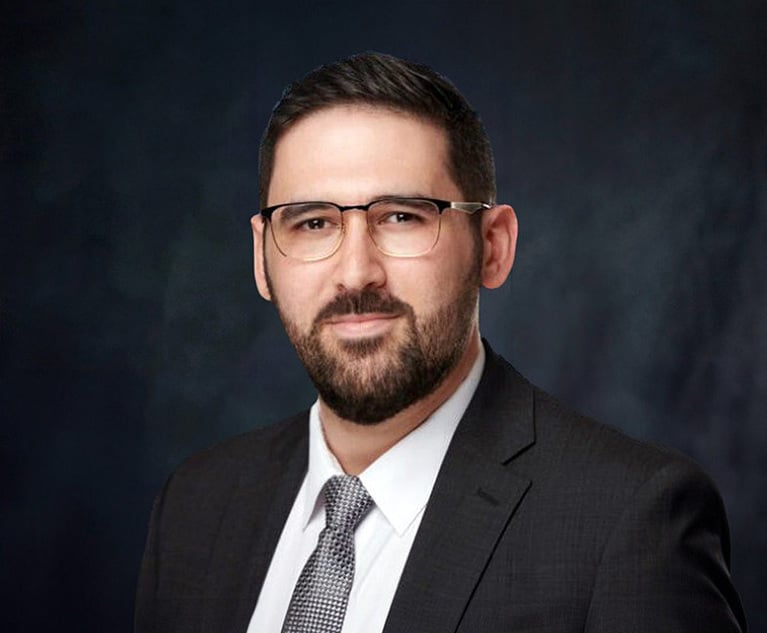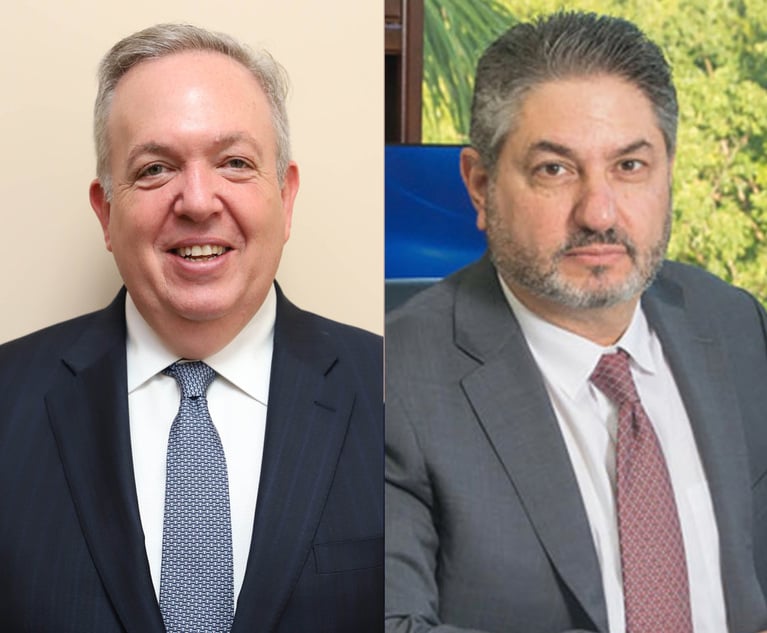Confusing Theories of Liability: Negligent Driving and Negligent Employment
Florida plaintiffs are pressing for the extinction of vicarious liability against employers for their employees' negligence. The plaintiffs are not trying to give employers a free pass. They seek to impose additional liability upon them for their employees' conduct and present prejudicial evidence to the jury.
July 20, 2020 at 09:12 AM
7 minute read
 Walter Latimer, left, and Bruno Renda, right, Shareholders with Fowler White Burnett.
Walter Latimer, left, and Bruno Renda, right, Shareholders with Fowler White Burnett.Florida plaintiffs are pressing for the extinction of vicarious liability against employers for their employees' negligence. The plaintiffs are not trying to give employers a free pass. They seek to impose additional liability upon them for their employees' conduct and present prejudicial evidence to the jury. When they sue, some plaintiffs are skipping claims for vicarious liability altogether. Instead, they opt for claims for direct negligence, such as for negligent hiring, training, retention, supervision and entrustment. Their goal is to open up discovery on the employers' operational details, hoping to weave a web of "institutional wrongdoing." Even if immaterial to the actual accident, this can lead to "reptile"-style narratives, causing juries to render verdicts out of fear for their safety.
This trend is particularly troublesome because it violates basic principles of tort law and has successfully led to many nuclear verdicts. This is particularly true in claims against motor carriers and commercial drivers, the very people keeping the country moving.
This issue requires revisiting Tort Law 101. Tort liability based on conduct. In its simplest form, tort law imposes financial consequences (liability) upon a party who harms another (fault). If Tom Driver negligently operates his vehicle and crashes into Paul Plaintiff, our courts will hold Driver financially responsible for Paul's injuries. Driver's conduct created his liability and caused Paul's injuries. This makes sense.
Over the years, the law developed to impose financial responsibility on an employer for its employee's conduct. In the business world, Mr. Boss tells Tom Driver to perform some work that results in harm to Paul. The concept of respondeat superior makes Mr. Boss vicariously responsible to Paul, even though it was Driver's conduct, not Mr. Boss's, which harmed Paul. The law allowed this simple scheme for public policy reasons. It holds financially solvent parties responsible for the acts of their agents who may not be able to pay for the harm they caused, even though the employer's conduct that did not directly cause any harm.
The law also made accommodations for an employer who denies responsibility for their employee's wrongdoing. If Mr. Boss denies Driver was its employee or denies that Driver was acting at its behest when he harmed Paul, Paul can still seek compensation from the employer by asserting claims for negligent hiring, training, retention, supervision, or entrustment. This scenario first arose in cases where the employee committed an intentional tort, or greatly deviated his job description in committing the harm. In those circumstances, tort law gives plaintiffs an opportunity to prove that the employer should be responsible for the harm caused by its agent's deviation from his job responsibilities. Paul must prove that Mr. Boss knew or should have known that Driver was likely to cause the sort of harm Paul sustained.
In the trucking world, legislators went a step further to ensure motor carriers could not dodge responsibility for their drivers' behavior. The drafters of the Federal Motor Carrier Safety Act anticipated that motor carriers would attempt to avoid liability by casting their commercial drivers as independent contractors. For that reason, the Act abolished the distinction between "employee" and "independent contractor" by defining employees as "any individual, other than an employer, who is employed by an employer and who in the course of his or her employment directly affects commercial motor vehicle safety. Such term includes a driver of a commercial motor vehicle (including an independent contractor while in the course of operating a commercial motor vehicle), a mechanic, and a freight handler." This definition ensured that the doctrine of respondeat superior also applies to motor carriers regardless of the contractual nature of their relationship with their drivers.
Admittedly, this is a simplistic description of a complex set of legal doctrines. Nevertheless, this illustration demonstrates the current state of tort law in Florida. An employer will not be exempt from liability because it did not itself commit the tort, or because its employee strayed from his job description while committing the tort. In either circumstance, the employer's liability is derivative and directly dependent upon the same basis, i.e., the employee's wrongful conduct. Simply put, Boss cannot be liable for anything unless Driver caused an accident.
This distinction is vitally important. No matter how flawed the employer's hiring and training practices may be, there can be no liability against the employer unless there was wrongful conduct by its employee. If the employer admits that it is responsible for its employee's conduct, the employer's conduct is no longer an issue. This satisfies the public policy considerations and provides the plaintiff a financially responsible party to respond to the harm Driver caused. The conduct of Mr. Boss becomes irrelevant.
Plaintiffs in trucking accidents now try to merge disparate theories of vicarious liability with direct negligence. They often allege claims of negligence against the driver, and negligent hiring and training against the motor carrier, while omitting any reference to the motor carrier's vicarious liability. This preventing the motor carrier from admitting its vicarious liability for its driver. The ultimate goal is to expose the jury to the motor carrier's own conduct, which can consist of poor recordkeeping or sloppy maintenance. As negligent as these acts may be, they did not cause the plaintiff's harm. The only role of these non-driving acts is to paint the company as a bad actor and prejudice it before a jury.
To be clear, Florida law always has, and still does, prohibits this type of gamesmanship. With limited exception, claims for vicarious liability and claims for negligent hiring, training, retention, supervision, or entrustment, cannot coexist. Our courts allowed these theories to give plaintiffs the same redress against the motor carrier, and allow recovery of the same damages, as they might against the driver. It makes neither logical nor legal sense for a plaintiff to maintain a claim for negligent hiring, training, retention, supervision, or entrustment, when the motor carrier admits that it is responsible for its driver's conduct. There are no additional damages available, just as there was no additional harm. Any liability faced by a motor carrier is necessarily derivative, regardless of how artfully they draft their claims. Courts must continue to allow plaintiffs to recover their damages caused by negligent driving but prevent them from a second recovery against the employer.
Defendants should take an aggressive approach when these issues arise. It is easy to ignore the distinctions between "liability" and "fault," and to allow plaintiffs to reach trial with claims of direct negligence against motor carriers who accept their responsibility for their drivers. There is no reason to allow discovery against motor carriers in these circumstances, much less to list commercial drivers and motor carrier separately on verdict forms.
Walter G. Latimer in Miami and Bruno Renda in Fort Lauderdale are shareholders at Fowler White Burnett. They focus on catastrophic personal injury and wrongful death defense. Contact Latimer at wlatimer@fowler‐white.com and Renda at rendab@fowler‐white.com.
This content has been archived. It is available through our partners, LexisNexis® and Bloomberg Law.
To view this content, please continue to their sites.
Not a Lexis Subscriber?
Subscribe Now
Not a Bloomberg Law Subscriber?
Subscribe Now
NOT FOR REPRINT
© 2025 ALM Global, LLC, All Rights Reserved. Request academic re-use from www.copyright.com. All other uses, submit a request to [email protected]. For more information visit Asset & Logo Licensing.
You Might Like
View All
Conversation Catalyst: Transforming Professional Advancement Through Strategic Dialogue
5 minute read
SEC Whistleblower Program: What to Expect Under the Trump Administration
6 minute read
Turning the Shock of a January Marital Split Into Effective Strategies for Your Well-Being
5 minute read
Trending Stories
- 1States Accuse Trump of Thwarting Court's Funding Restoration Order
- 2Microsoft Becomes Latest Tech Company to Face Claims of Stealing Marketing Commissions From Influencers
- 3Coral Gables Attorney Busted for Stalking Lawyer
- 4Trump's DOJ Delays Releasing Jan. 6 FBI Agents List Under Consent Order
- 5Securities Report Says That 2024 Settlements Passed a Total of $5.2B
Who Got The Work
J. Brugh Lower of Gibbons has entered an appearance for industrial equipment supplier Devco Corporation in a pending trademark infringement lawsuit. The suit, accusing the defendant of selling knock-off Graco products, was filed Dec. 18 in New Jersey District Court by Rivkin Radler on behalf of Graco Inc. and Graco Minnesota. The case, assigned to U.S. District Judge Zahid N. Quraishi, is 3:24-cv-11294, Graco Inc. et al v. Devco Corporation.
Who Got The Work
Rebecca Maller-Stein and Kent A. Yalowitz of Arnold & Porter Kaye Scholer have entered their appearances for Hanaco Venture Capital and its executives, Lior Prosor and David Frankel, in a pending securities lawsuit. The action, filed on Dec. 24 in New York Southern District Court by Zell, Aron & Co. on behalf of Goldeneye Advisors, accuses the defendants of negligently and fraudulently managing the plaintiff's $1 million investment. The case, assigned to U.S. District Judge Vernon S. Broderick, is 1:24-cv-09918, Goldeneye Advisors, LLC v. Hanaco Venture Capital, Ltd. et al.
Who Got The Work
Attorneys from A&O Shearman has stepped in as defense counsel for Toronto-Dominion Bank and other defendants in a pending securities class action. The suit, filed Dec. 11 in New York Southern District Court by Bleichmar Fonti & Auld, accuses the defendants of concealing the bank's 'pervasive' deficiencies in regards to its compliance with the Bank Secrecy Act and the quality of its anti-money laundering controls. The case, assigned to U.S. District Judge Arun Subramanian, is 1:24-cv-09445, Gonzalez v. The Toronto-Dominion Bank et al.
Who Got The Work
Crown Castle International, a Pennsylvania company providing shared communications infrastructure, has turned to Luke D. Wolf of Gordon Rees Scully Mansukhani to fend off a pending breach-of-contract lawsuit. The court action, filed Nov. 25 in Michigan Eastern District Court by Hooper Hathaway PC on behalf of The Town Residences LLC, accuses Crown Castle of failing to transfer approximately $30,000 in utility payments from T-Mobile in breach of a roof-top lease and assignment agreement. The case, assigned to U.S. District Judge Susan K. Declercq, is 2:24-cv-13131, The Town Residences LLC v. T-Mobile US, Inc. et al.
Who Got The Work
Wilfred P. Coronato and Daniel M. Schwartz of McCarter & English have stepped in as defense counsel to Electrolux Home Products Inc. in a pending product liability lawsuit. The court action, filed Nov. 26 in New York Eastern District Court by Poulos Lopiccolo PC and Nagel Rice LLP on behalf of David Stern, alleges that the defendant's refrigerators’ drawers and shelving repeatedly break and fall apart within months after purchase. The case, assigned to U.S. District Judge Joan M. Azrack, is 2:24-cv-08204, Stern v. Electrolux Home Products, Inc.
Featured Firms
Law Offices of Gary Martin Hays & Associates, P.C.
(470) 294-1674
Law Offices of Mark E. Salomone
(857) 444-6468
Smith & Hassler
(713) 739-1250






